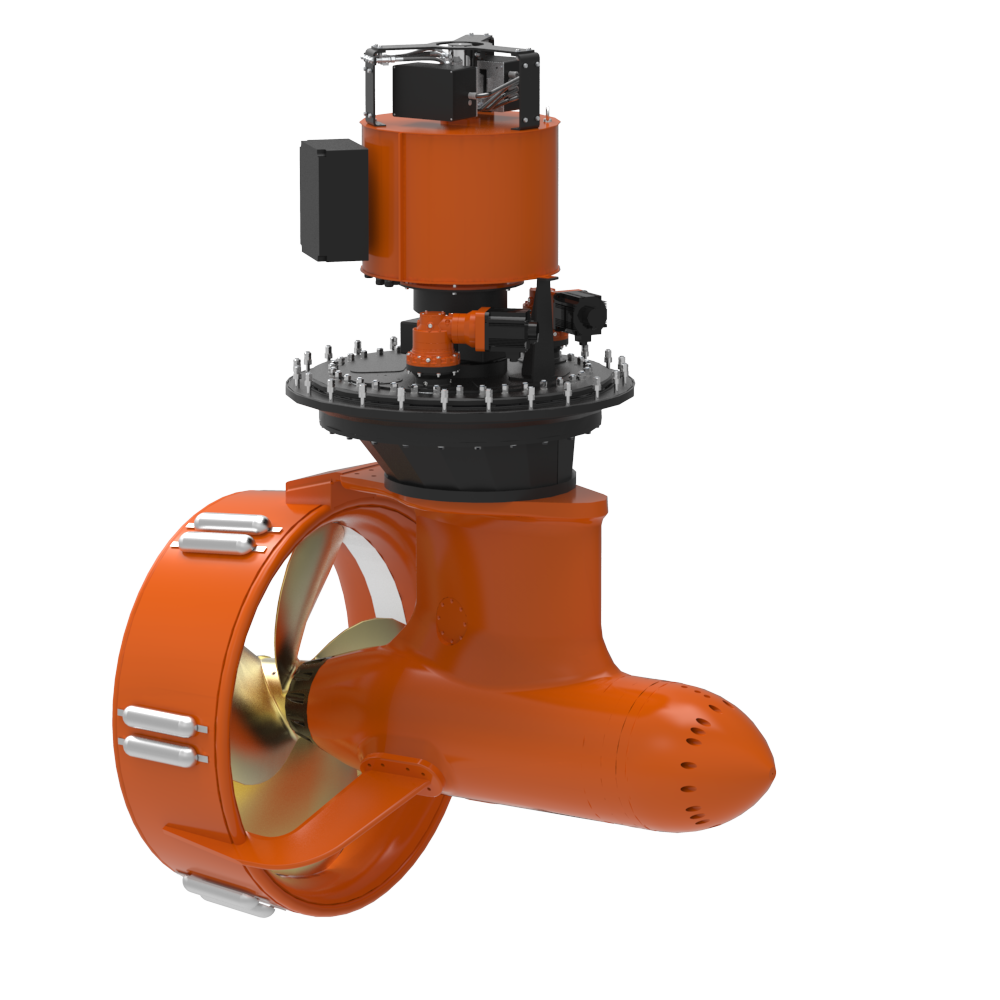By: Johnray Strickland
As the older offshore oil and gas production fields are approaching the end of their useful life, the industry is moving to deeper waters to find replacement fields. Significant ultra-deepwater fields in water depth greater than 1,500 meters have been found off the coasts of Brazil, the Gulf of Mexico and West Africa. These fields are typically several hundreds of kilometers away from the closest port. The support and supply vessels serving drillships, FPSO’s and other floating facilities must be capable of traveling these long distances within a reasonable time.
A traditional OSV cruising at 13 knots takes 15 to 24 hours each way bringing and returning fluids, supplies and equipment to the rig. In many cases, that is too long. This has created a need for faster vessels. This new generation of vessels is known as FSV’s (Fast Supply Vessels). FSV’s are usually built in aluminum material and have cruising speeds in the range of 25 to 40 knots. Most FSV’s transport crews as well as supplies. They are equipped with dynamic positioning systems to IMO standards DP-2 or DP-3.
To accommodate the need for speed as well as the DP capability requirement, Thrustmaster offers waterjets for main propulsion of these vessels. Thrustmaster’s waterjets cover a range from 100kW to 6,400kW. They are equipped with reverse buckets of double cheek design. In combination with the steering nozzle, the double cheek bucket allows a large envelope of jet direction angles, facilitating the kind of vector control needed for dynamic positioning. The jets are made in marine grade aluminum with a 316 stainless steel pump section to provide long term longevity and reliability in this demanding application.
Direct Thrust
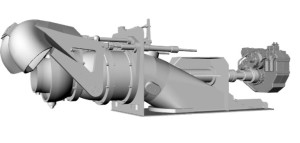 In addition to the standard jet packages, Thrustmaster of Texas, Inc. has a range of optional supply and installation configurations giving designers, builders and owners flexibility with installation, operation and budget. The standard 100, 200 and 300 series waterjets have a thrust bearing integrated into the jet shafting design. Where a gearbox is fitted, the “Direct Thrust” option takes advantage of the gearbox thrust bearing to allow the jet thrust to be taken directly on the gearbox, reducing weight, cost, complexity and maintenance. The package includes an alignment tool to simplify installation and customized shafting for direct connection to the gearbox without adapters.
In addition to the standard jet packages, Thrustmaster of Texas, Inc. has a range of optional supply and installation configurations giving designers, builders and owners flexibility with installation, operation and budget. The standard 100, 200 and 300 series waterjets have a thrust bearing integrated into the jet shafting design. Where a gearbox is fitted, the “Direct Thrust” option takes advantage of the gearbox thrust bearing to allow the jet thrust to be taken directly on the gearbox, reducing weight, cost, complexity and maintenance. The package includes an alignment tool to simplify installation and customized shafting for direct connection to the gearbox without adapters.
Integrated Waterjet Installation
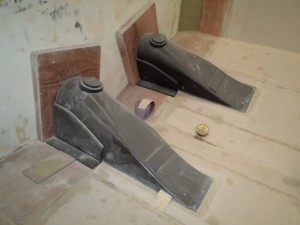 Another unique option is the “Integrated Waterjet.” Intended for production GRP vessels where the upper part of the intake duct is molded into the hull and the lower part of the intake duct is supplied as a casting that bolts to the hull to complete the enclosed duct. The pump assembly is supplied complete and bolts to the duct, greatly simplifying installation and reducing costs. This option also uses the “Direct Thrust” arrangement.
Another unique option is the “Integrated Waterjet.” Intended for production GRP vessels where the upper part of the intake duct is molded into the hull and the lower part of the intake duct is supplied as a casting that bolts to the hull to complete the enclosed duct. The pump assembly is supplied complete and bolts to the duct, greatly simplifying installation and reducing costs. This option also uses the “Direct Thrust” arrangement.
Recently, a 36m Monohull Crewboat, the BS Camburi, was launched and delivered after being built in Brazil by Arpoador Engenharia to the Petrobras type P2 specification for fleet owner Brasil Supply.
This aluminium crewboat was designed by Incat Crowther and is powered by triple CAT C32 ACERT diesel engines coupled to three Thrustmaster DJ290 waterjets. The seventh vessel delivered to Brasil Supply equipped with Thrustmaster waterjets, this vessel will transport up to 70 passengers and crew as well as carry 50t deck cargo plus fuel and fresh water cargo at a fully loaded service speed of 17+ knots.
For maximum service life in this arduous commercial application the Thrustmaster DJ290 waterjets have been specified with stainless steel pump assemblies fitted with 737mm high volume single stage axial flow impellers.
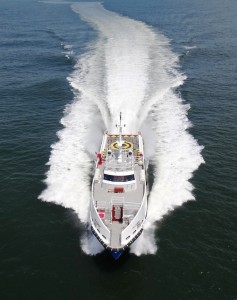 These waterjets provide excellent high-speed efficiency with superior cavitation margins allowing full power application at any load condition and also at zero speed for maximum possible thrust during docking and station keeping maneuvers at sea. Thrustmaster’s pre-fabricated aluminium intake duct installation combines maximum vessel integrity with simple installation.
These waterjets provide excellent high-speed efficiency with superior cavitation margins allowing full power application at any load condition and also at zero speed for maximum possible thrust during docking and station keeping maneuvers at sea. Thrustmaster’s pre-fabricated aluminium intake duct installation combines maximum vessel integrity with simple installation.
Each DJ290 has its own fully integrated hydraulic system providing steering and reverse control. All of the hydraulic equipment including cylinders hydraulic and associated hose connections are completely inboard mounted. All hydraulic pumps are directly driven from the gearbox PTO’s.
Vessel propulsion control is managed using Thrustmaster’s own CAN BUS – Control system. Configured for triple engine – twin station; the system simply combines primary control of engine throttle and gear command with the waterjet steering and reverse functions and all necessary monitoring, alarm and back-up control functions. The second (rear facing) station has been fitted with Thrustmaster’s eDOCK joystick control system. This provides a single joystick lever control that simultaneously actuates and controls waterjets and engines for precise and intuitive low speed maneuvering control.
The waterjets and control system are supplied to DNV HSCLC R2 CARGO B CREW boat.
Complete Dynamic Positioning Solution
To complete the DP capability of Fast Supply Vessels, Thrustmaster offers complete product lines of aluminum tunnel thrusters and aluminum retractable azimuth thrusters. The first Thrustmaster aluminum tunnel thrusters were built for aluminum hull mine hunters of the US Navy in 1984. Hundreds of aluminum thrusters have since been supplied to aluminum boat builders in Louisiana, Mississippi and Alabama starting in 1987. Almost all of those vessels are still operating and thruster failures are rare.
In recent years, shipyards in Brazil, Dubai, Vietnam, Hong Kong, France, The Netherlands, Thailand, Malaysia and many other locations started building aluminum FSV’s.
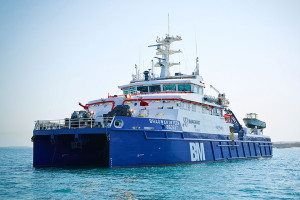 Incat Crowther’s new Catamaran Dive Support Vessel (DSV), Bhagwan Dryden, is making waves in the DSV sector and has already received high praise throughout its initial operational feedback for its dynamic positioning operations in shallow, rough seas since its launch and delivery earlier this year as reported by Incat Crowther.
Incat Crowther’s new Catamaran Dive Support Vessel (DSV), Bhagwan Dryden, is making waves in the DSV sector and has already received high praise throughout its initial operational feedback for its dynamic positioning operations in shallow, rough seas since its launch and delivery earlier this year as reported by Incat Crowther.
The 187 ft (57 m) Bhagwan Dryden is the first catamaran dive support vessel with such a high level of integrated dive systems. The vessel has been designed from the keel up to perform six key roles; Dive Support, Geophysical Survey, Geotechnical Survey, Cargo Transport, Hyperbaric Rescue and Safety Standby.
The vessel can work in shallow waters, offering operational efficiencies at these depths and is fitted with an ROV, two built in decompression chambers and two Pommec launch and recovery systems, with the diving systems boasting a depth rating of 164 ft (50 m).
With such a varied array of operational roles, unique solutions were required not only in the allocation of spaces, but also with the specification of a flexible, high-redundancy propulsion system.
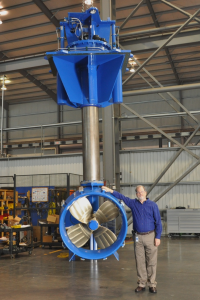 The result is an advanced propulsion and powering package that integrates a pair of Thrustmaster TH300MLRT 300 hp (220 kW) azimuthing retractable combi bow thrusters, azimuthing stern drives, and generators. Bhagwan Dryden is fitted with four generator sets (two Cummins QSK38-M’s and two QSK19-M’s), overseen by an advanced power management system that makes optimal use of the four generators and a battery bank to ensure each power source is used in the most effective way. The battery bank stores enough power to propel the ship for short periods, whilst the generators can be powered up in stages to minimize fuel burn. The system offers both excellent low-speed efficiency (7 knots requires just 25% power) and maneuverability and a laden speed of 11 knots.
The result is an advanced propulsion and powering package that integrates a pair of Thrustmaster TH300MLRT 300 hp (220 kW) azimuthing retractable combi bow thrusters, azimuthing stern drives, and generators. Bhagwan Dryden is fitted with four generator sets (two Cummins QSK38-M’s and two QSK19-M’s), overseen by an advanced power management system that makes optimal use of the four generators and a battery bank to ensure each power source is used in the most effective way. The battery bank stores enough power to propel the ship for short periods, whilst the generators can be powered up in stages to minimize fuel burn. The system offers both excellent low-speed efficiency (7 knots requires just 25% power) and maneuverability and a laden speed of 11 knots.
Thrustmaster of Texas, Inc. designs and manufactures commercial marine propulsion thrusters at the largest thruster factory in the world. Located in Houston, Texas with international offices in Singapore, China, Rotterdam, Dubai, and Brazil.









